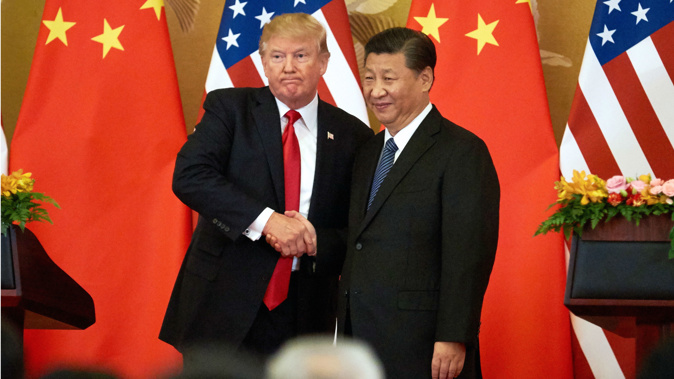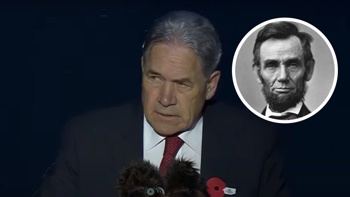
All the usual rituals of international summits were there: The group photos, the gala dinners, the noticeably vibrant shirts leaders force themselves into. But eclipsing all of that at Asia's two big meetings was some unusually forthright criticism that exposed deepening divisions rattling the region.
Front and centre was the rivalry between the United States and China. The two countries are locked in a widening trade war and their representatives used the summits to exchange barbs and manoeuvre to expand their influence.
Competition between the great powers is not new to the region. But over decades of war, financial crises and other setbacks, countries across Asia and the Pacific Rim have used these annual meetings to talk through such problems, usually opting to sideline disagreements in a show of unity. Consensus, not conflict, is typically the norm.
This year is different.
The clash between the world's two biggest economies is shaking the bedrock of regional amity and leaving some countries worried they will be forced to choose between Beijing and Washington.
It also may bode poorly for compromise between Presidents Donald Trump and Xi Jinping when they meet at the Group of 20 (G-20) gathering in Buenos Aires, Argentina, next week.
The antagonisms kicked off last week at a Southeast Asian (Asean) summit in Singapore, where US Vice-President Mike Pence, standing in for Trump, declared that "empire and aggression have no place" in the region, a clear reference to Chinese expansion in the disputed South China Sea. The discord carried over to the Asia-Pacific Economic Co-operation (Apec) forum in Papua New Guinea, where leaders failed for the first time in nearly 30 years of such gatherings to endorse a final joint statement. China apparently pushed back hard against US demands for strong language against unfair trade practices.
Pence and Chinese leaders sparred at both summits, with the Vice-President describing China's militarisation and expansion in the South China Sea as "illegal and dangerous". He accused Beijing of threatening the sovereignty of many nations and said it "endangers the prosperity of the world".
Chinese Premier Li Keqiang smacked back, urging fellow leaders to send a positive message to markets ruffled by the trade war, which has seen both sides imposing punitive tariffs on billions of dollars of each other's exports and has the potential to unravel supply chains across the globe.
The acrimony may be somewhat less apparent at the G-20 gathering in Buenos Aires, which will include leaders from across the globe and where the focus will be global, not regional.
But the strains between the US and China were painful enough in Singapore that the gathering's urbane host, Prime Minister Lee Hsien Loong, appealed for a bit less candour and greater camaraderie, saying it would be easier if everybody was "on the same side".
Across Asia, countries worry they will have to "choose one or the other", he said. "I hope it does not happen soon."
Most Asian nations are loathe to make such a choice because they benefit from the rivalry, whether economically, militarily or both. For most, China is their largest trading partner.
But they are wary of China's military might and see the US and its presence in the region as a welcome counterbalance.
China's footprint was everywhere in the Papuan capital, Port Moresby, from a showpiece boulevard and international convention centre built with Chinese help to bus stop shelters sporting "China Aid" plaques. A huge billboard showed Xi gazing beneficently beside Papua New Guinea's leader.
At that meeting, Pence took aim at China's global infrastructure drive, known as the "Belt and Road Initiative", suggesting Beijing was drowning its partners in debt and infringing on their sovereignty.
He also announced the US would join ally Australia's plan to develop a naval base in Papua New Guinea. That followed a hush-hush working level meeting in Singapore of the Quadrilateral Security Dialogue, which involves the US, Japan, Australia and India and is viewed as a challenge to China's expanding military reach.
Xi suggested the US was bending the rules of global institutions set up after World War II, such as the World Trade Organisation, and using them for "selfish agendas".
As China and the US manoeuvre for influence across a region stretching from India to the tip of South America, the biggest worry is that the jousting could escalate into a full-blown confrontation as Chinese and US warships and aircraft prowl the region.
A near collision of a Chinese destroyer and the USS Decatur near a disputed reef in the South China Sea in late September added to those concerns.
Still, the jostling for supremacy comes with mixed signals.
The regional summitry over, two US B-52 bombers on Monday flew over the South China Sea in what US Pacific Air Forces said was a "routine training mission".
But on Wednesday, the aircraft carrier USS Reagan docked in Hong Kong in what was viewed as a friendly gesture - it required Beijing's approval.
Take your Radio, Podcasts and Music with you









